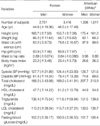1. National Institutes of Health. NIH Publication 01-3670. Third Report of the National Cholesterol Education Program Expert Panel on Detection, Evaluation, and Treatment of High Blood Cholesterol in Adults (Adult Treatment Panel III). 2001. Bethesda: National Institutes of Health.
2. Reaven GM. Banting lecture 1988: Role of insulin resistance in human disease. Diabetes. 1988. 37:1595–1607.

3. Wilson PW, Kannel WB, Silbershatz H, D'Agostino RB. Clustering of metabolic factors and coronary heart disease. Arch Int Med. 1999. 159:1104–1109.

4. Trevisan M, Liu J, Bahsas FB, Menotti A. for the Risk factors and Life Expectancy Research Group. Syndrome X and mortality: a population-based study. Am J Epidemiol. 1998. 148:958–966.

5. Isomaa B, Almgren P, Tuomi T, Forsen B, Lahti K, Nissen M, Taskinen MR, Groop L. Cardiovascular morbidity and mortality associated with the metabolic syndrome. Diabetes Care. 2001. 24:683–689.

6. Zimmet P, Alberti KGMM, Shaw J. Global and societal implications of the diabetes epidemic. Nature. 2001. 414:782–787.

7. Kim SW, Kim JY, Kim ES, Kim YI, Lee MS, Kim HH, Park JY, Hong SK, Lee KU. Prevalence of insulin resistance syndrome in subjects living in Jungup district, Korea. J Korean Diabet Assoc. 1999. 23:70–78.
8. Lee HJ, Yoon JS, Shin DH. Patterns of insulin resistance syndrome in the Taegu community for the development of nutritional service improvement programs. Korean J Community Nutrition. 2001. 6:97–107.
9. Kim BS. Prevalence of metabolic syndrome for Koreans: Among the clients of comprehensive medical examination in one university hospital. Korean J Health Promotion Disease Prevention. 2002. 2:17–26.
10. Park SH, Lee WY, Kim SW. The relative risks of the metabolic syndrome defined by adult treatment panel III according to insulin resistance in Korean population. Korean J Med. 2003. 64:552–560.
11. Lym YL, Hwang SW, Shim HJ, Oh EH, Chang YS, Cho BL. Prevalence and risk factors of the metabolic syndrome as defined by NCEP-ATP III. J Korean Acad Fam Med. 2003. 24:135–143.
12. Chung HW, Kim DJ, Jin HD, Choi SH, Ahn CW, Cha BS, Lee HC, Huh KB. Prevalence of metabolic syndrome according to the new criteria for obesity. J Korean Diabet Assoc. 2002. 26:431–442.
13. Park JS, Park HD, Yun JW, Jung CH, Lee WY, Kim SW. Prevalence of the metabolic syndrome as defined by NCEP-ATP III among the urban Korean population. Korean J Med. 2002. 63:290–298.
14. Korea Institute of Health and Social Affairs. Summary Report: National Health and Nutrition Survey in 1998, Korea. 1999. Seoul: Ministry of Health & Welfare.
15. Okosun IS, Liao Y, Rotimi CN, Prewitt TE, Cooper RS. Abdominal adiposity and clustering of multiple metabolic syndrome in white, black, and hispanic Americans. Ann Epidemiol. 2000. 10:263–270.

16. Inoue S, Zimmet P, Catersen I, Chunming C, Ikeda Y, Khalid AK, Kim YS, Basesett J. The Asia-Pacific perspective: redefining obesity and its treatment: Health Communication Australia Pty. 2000.
17. Bjorntorp P. Body fat distribution, insulin resistance, and metabolic diseases. Nutrition. 1997. 13:795–803.

18. Alberti KG, Zimmet PZ. Definition, diagnosis and classification of diabetes mellitus and its complication. Part 1: Diagnosis and classification of diabetes mellitus, provisional report of a WHO consultation. Diabetic Medicine. 1998. 15:539–553.
19. Ford ES, Giles WH. A comparison of the prevalence of the metabolic syndrome using two proposed definitions. Diabetes Care. 2003. 26:575–581.

20. Brunner EJ, Marmot MG, Nanchahal K, Shipley MJ, Stansfeld SA, Juneja M, Alberti KGMM. Social inequality in coronary risk: central obesity and the metabolic syndrome. Evidence from the Whitehall II study. Diabetologia. 1997. 40:1341–1349.

21. Ford ES, Giles WH, Dietz WH. Prevalence of the metabolic syndrome among US adults: Findings from the third National Health and Nutrition Examination Survey. JAMA. 2002. 287:356–359.

22. Araneta MRG, Wingard DL, Barrett-Connor E. Type 2 diabetes and metabolic syndrome in Filipina-American women: A high-risk non-obese population. Diabetes Care. 2002. 25:494–499.
23. Fujimoto WY, Bergstrom RW, Boyko EJ, Chen K, Kahn SE, Leonetti DL, McNeely MJ, Newell LL, Shofer JB, Wahl PW. Type 2 diabetes and the metabolic syndrome in Japanese Americans. Diabetes Res Clin Pract. 2000. 50:S73–S76.

24. Kosaka K, Kuzuya T, Yoshinaga H, Hagura R. A prospective study of health check examination for the development of non-insulin-dependent diabetes mellitus: relationship of the incidence of diabetes with initial insulinogenic index and degree of obesity. Diabetic Medicine. 1996. 13:s120–s126.
25. McKeigue PM, Shah B, Marmot MG. Relation of central obesity and insulin resistance with high diabetes prevalence and cardiovascular risk in South Asians. Lancet. 1991. 337:382–386.











 PDF
PDF ePub
ePub Citation
Citation Print
Print


 XML Download
XML Download